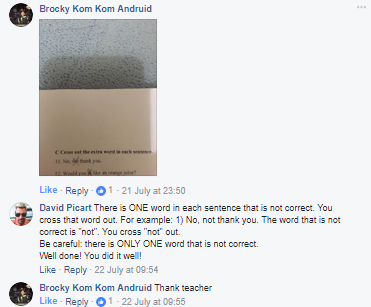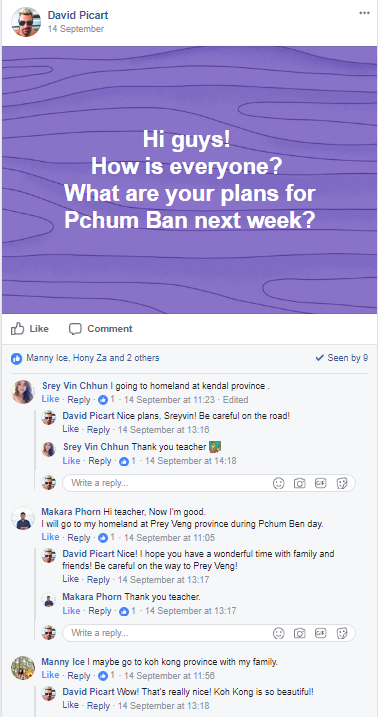e-Learning Ecologies MOOC’s Updates
Essential Update #7: An attempt at differentiating EFL practice with the help of Facebook groups
As Dr. Mary Kalantzis says in the video on Differentiated Learning, Part 7A:
“Working within digital spaces does allow us to harness the attention of every learner, to tailor make the learning to their needs, to track whether they are performing or not performing and to adjust what we are doing. It provides us with the affordances for ensuring that all learners can be engaged.”
For this last update, I would like to contribute a concrete example from my teaching practice in Cambodia and share my attempt at differentiate practice of EFL with the help of Facebook groups.
Differentiated teaching in a foreign language classroom has been the focus of many language teachers for a very long time.
Even in a classroom of total beginners, i.e. learners who have no prior knowledge of the language being taught, there is always a wide spectrum of abilities and profiles right from the very start: some are risk takers and speak spontaneously, some a risk averse and clam up from the get go, some need a period of latency before uttering a single word, some perceive the sounds of the foreign language better than others, etc. The list is endless.
When it comes to fluency in the foreign language, and to paraphrase the well-known quote according to which one does not learn a language, but merely get used to it, technology mediated by computers can not only help learners practice the language outside the classroom, referred to as ubiquitous learning, as it is done traditionally but can also help them practice it in a differentiated fashion, among themselves.
Indeed, fluency, whether in speaking or in writing, which is to be practiced and not learnt, is best achieved when learners practice according to their abilities or when learners with the same abilities practice together. Depending on the topics and other factors, such as the skills to be practiced (reading, writing, speaking or listening) learners are paired or grouped to work on various sets of activities.
New technology mediated by computers, such as popular social media like Facebook or Twitter, can enable learners to practice and collaborate on these sets of activities more easily and interactively.
Here is an example of two learners, who had missed classes due to other commitments in the provinces in Cambodia, being asked to describe their day in order to keep on practicing their English. (Their names have not been blanked as they gave consent).
Here is another example of a learner, who had to miss class because of work commitment, having photographed a part of his supplementary homework in order to ask a question related to the instructions that he had not understood. (His name has not been blanked as he gave consent).
Here is a third example of learners practicing writing sentences about their plans for Pchum Ban (Ancestor Day here in Cambodia) according to their abilities. (Their names have not been blanked as they gave consent).
As we can see, even a popular social medium like Facebook, can be easily used to differentiate learning and enable learners to practice the language according to their abilities at the time, but also their motivation and available times that they have.
REFERENCE:
Differentiating Instruction for EFL Learners, Laura A. Borja, Sandy T. Soto, Tatiana X. Sanchez, International Journal of Humanities and Social Science, http://www.ijhssnet.com/journals/Vol_5_No_8_1_August_2015/5.pdf





nice post
NSP
NSP Login
Natinal Schoplarship Portal
Dipu
Everything in your article was on the right track. I have not seen a better and genuine article than this in quite a long time. K9 Roof Rack System
Nice Post thanks for the information, good information & very helpful for others.It is very helpful and very informative and I really learned a lot from it.
Mobile No Tracker
Mobile location Tracker
IMEI Tracker
Mobile Phone Tracking
Best Mobile Number Tracker with Google Map
Avishek
nice post
Phone number tracker
mobile number locator
Best Mobile number tracker with google map
Phone number tracker
career objective
free online caree councelling
unique caree guidance
Patanjali Distribution
Patanjali Distribution
Amul Franchise
Dipu
that looks to be definitely extraordinary. an amazing range of teeny facts are supposed experiencing exquisite deal
of heritage competencies. I could be fascinated the factor a large quantity.
Disc Gold Baskets
Hər növ tərcümələri uyğun qiymət və yüksək keyfiyyətlə əldə etmək üçün tərcümə xidməti bu linkə daxil ola bilərsiniz.
sinxron tercume bu linkə daxil ola bilərsiniz.
Ətraflı isə çatdırılma ilə isə xaricden sifaris linkdən tanış ola bilərsiniz
Sosial media marketinq günümüzün ve geleceyin en effektiv reklam modellerindən biridir. Bu sebebdendir ki, SMM xidməti
dünyanın tanınmıs brendleri terefinden xususi diqqet merkezinde saxlanılır.
Seo xidməti haqqında məlumat almaq üçün seo xidmeti bu linkə daxil ola bilərsiniz.
I can tell you're enjoying what you are doing it clearly reflect to your amazing post. I'll choose your site over anyone when comes to quality blog content. workmans comp attorney helena